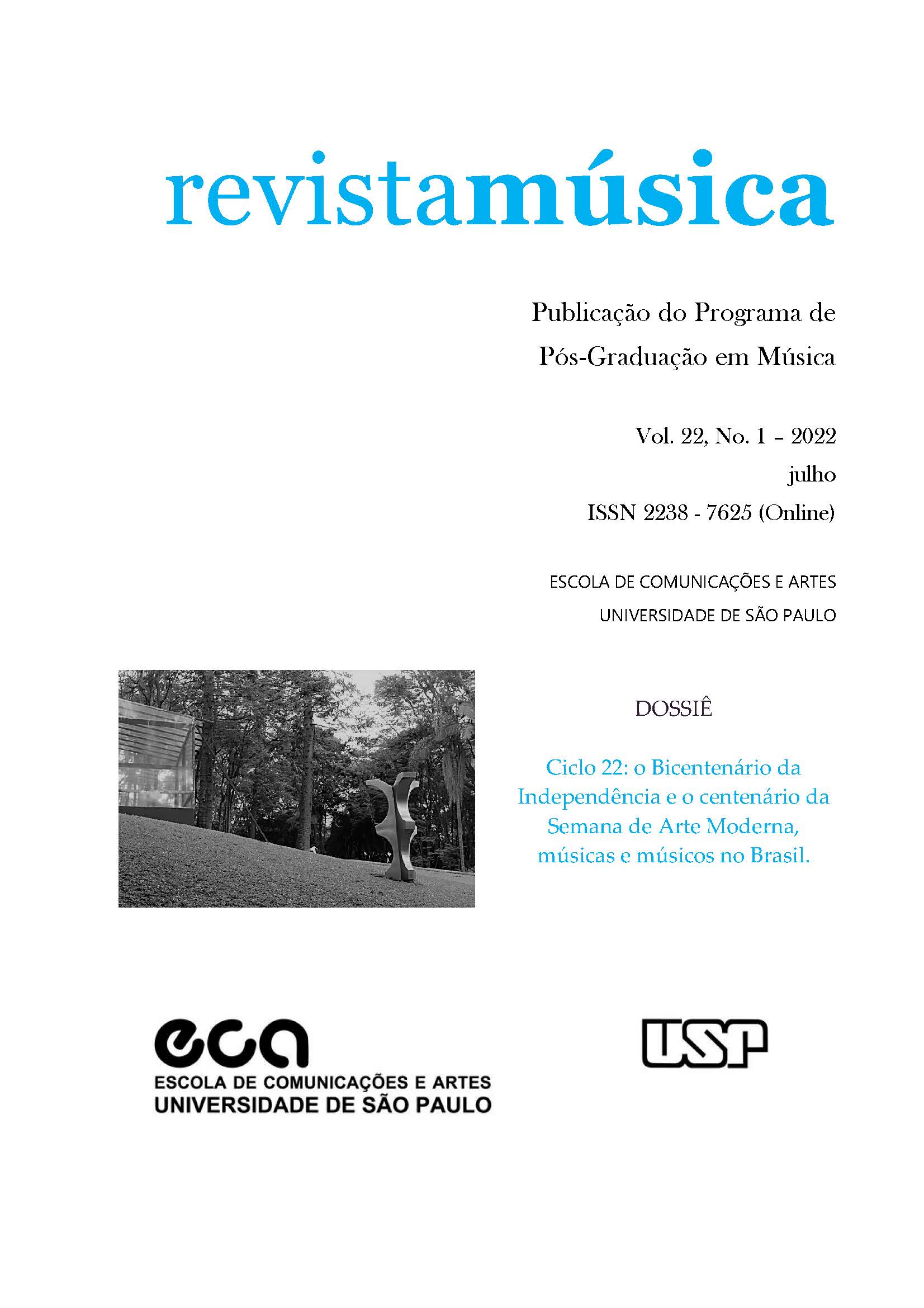Stimmung , by Karlheinz Stockhausen: improvisation, musical notation, experiences and aesthetic interactions and cultural mediations in the ways of making music under the influence of the East and multiple cultures from the second half of the 20th century
DOI:
https://doi.org/10.11606/rm.v22i1.194702Keywords:
Stimmung, Karlheinz Stockhausen, Cultural multiplicity, Musical analysis, Musical notationAbstract
From the second half of the twentieth century the decline of the representation of sound through traditional notation, especially in Europe, is enhanced by the flourishing of cultural multiplicity and languages and aesthetics, especially from the East. This article aims to examine the processes of creating the work Stimmung, by Karlheinz Stockhausen - admittedly the first Western vocal work based entirely on the production of vocal harmonics - where, from a single height, in a work of about 75 minutes duration, the composer works with sounds that refer to the tradition of exotic rites and ceremonies when interacting with sound and textual elements from various cultural agents.Downloads
References
ARAÚJO COSTA, Fabiano. Notas sobre a experiência estética interacional nos grupos de Miles Davis em 1969: o projeto de “Bitches Brew” e os concertos com o 3º Quinteto. Revista de estudos do Jazz e das Músicas Audiotáteis. Caderno em Português, nº 2, CRIJMA – IReMus – Sorbonne Université, dezembro de 2020, p. 1-20. Disponível em: https://api.nakala.fr/data/10.34847/nkl.cafbn6y9/46e2fde07d496a49c236c835a0a774dc9b75b043. Acesso em: 30 de julho de 2021.
ASSIS, Gustavo Oliveira Alifax. Em busca do som: A Música de Karlheinz Stockhausen nos anos 1950. São Paulo: Editora Unesp, 2011.
BRADELL, Rory. Essay on Stockhausen's work for six vocalists, Stimmung. Disponível em http://homepage.tinet.ie/~braddellr/stock/. Acesso em 02 de agosto de 2021.
COOK, Nicholas: A Guide to Musical Analysis. London: Norton, 1987.
CORRENTINO, Diones; TINÉ, Paulo José de S.; DOS SANTOS, Antônio Rafael. Audiotatilidade e invenção em Frevo de Egberto Gismonti. In: XXIX Congresso da Anppom-Pelotas/RS. 2019. Disponível em: https://anppom.com.br/congressos/index.php/29anppom/29CongrAnppom/paper/view/5727. Acesso em: 03 de agosto de 2021.
COTT, Jonathan. Stockhausen — Conversations with the composer. London: Robson, 1974.
MACONIE, Robin. Stockhausen sobre a música — palestras e entrevistas compiladas por Robin Maconie. São Paulo: Madras, 2009.
PAREYSON, Luigi. Estética: Teoria da Formatividade. [Trad.] Ephraim Ferreira Alves. Rio de Janeiro: Vozes, 1993.
STOCKHAUSEN, Karlheinz. Stimmung. Para seis vozes amplificadas. Partitura. Universal Edition, 2000. 21 páginas.
ROSE, Gregory / Singcircle. Stockausen Stimmung. CD. Encarte com notas de Gregory Rose e Helen Ireland. London: Hyperion, 1983.
WÖRNER, Karl H. Stockhausen — Life and Works. London: Faber and Faber, 1973.
Downloads
Published
Issue
Section
License
Copyright (c) 2022 Diogo Rebel e Carvalho

This work is licensed under a Creative Commons Attribution-NonCommercial-ShareAlike 4.0 International License.
Autores que publicam nesta revista concordam com os seguintes termos:
- Autores mantém os direitos autorais e concedem à revista o direito de primeira publicação, com o trabalho simultaneamente licenciado sob a CC Attribution-NonCommercial-ShareAlike 4.0 que permite o compartilhamento do trabalho com reconhecimento da autoria e publicação inicial nesta revista.
- Autores têm autorização para assumir contratos adicionais separadamente, para distribuição não-exclusiva da versão do trabalho publicada nesta revista (ex.: publicar em repositório institucional ou como capítulo de livro), com reconhecimento de autoria e publicação inicial nesta revista.
- Autores têm permissão e são estimulados a publicar e distribuir seu trabalho online (ex.: em repositórios institucionais ou na sua página pessoal) a qualquer ponto antes ou durante o processo editorial, já que isso pode gerar alterações produtivas, bem como aumentar o impacto e a citação do trabalho publicado (Veja O Efeito do Acesso Livre).


